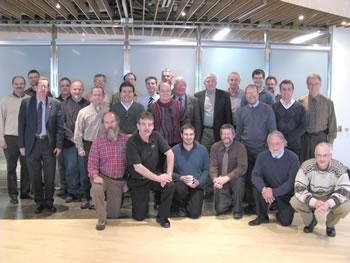 The Centre for Excellence in Mining Innovation (CEMI) is laying the groundwork for an International Fault Slip Control Research Initiative (IFSCRI) to better understand fault slip rockbursting.
The Centre for Excellence in Mining Innovation (CEMI) is laying the groundwork for an International Fault Slip Control Research Initiative (IFSCRI) to better understand fault slip rockbursting.
"Mining companies in the Sudbury Basin are going deeper - particularly Vale Inco - and they recognize that the issue of fault slip rockbursting is something that needs to be dealt with if the risks associated with their plans to go deeper are going to be mitigated," said Damien Duff, CEMI R&D program manager. "So, they came to us and asked us if there was anything we could do to understand fault slip rockbursting better and figure out a way to control all the energy associated with one of these events."
Fault slip rockbursting is caused by failure or slippage that can occur on or near a fault or fracture, particularly where it intersects underground mine infrastructure.
"It's like an earthquake," said Duff. "Stress builds up over time until, eventually, strain or deformation occurs and, all of a sudden, all of this energy gets released."
In 1985, a 3.8 magnitude fault slip rockburst at a Falconbridge mine in Sudbury was responsible for the death of four miners. The Stevenson Royal Commission probed the cause of the disaster and CAMIRO undertook a research project led by Laurentian University's Peter Kaiser, now president and CEO of CEMI. However, to date, "we have failed to understand completely the cause of fault slip rockbursting and the way to control the energy release associated with one of these events," said Duff.
"Once we get below 1,000 or 1,500 metres, we're at the sweet spot in the Earth's crust, where stresses are such that fault slip rockbursting tends to become more common. In our view, it's a problem that's bigger than just CEMI. It's as big as mining, so we decided to involve a large group of potential stakeholders to help us solve it."
CEMI decided to focus its research on four disciplines: seismicity, geophysical tools and methodologies, structural and engineering geology and numeric modelling. It then proceeded to organize a series of workshops - one for each research stream - and it invited experts from around the world.
The first one, held in October 2009, brought together experts in seismicity and microseismicity from Canada, Australia, South Africa, Europe and the United States. A second workshop was held in December on geophysical tools and technology, co-led by Bernd Milkereit, Teck Chair of Exploration Geophysics at the University of Toronto. A third workshop focused on structural and engineering geology was held in January and the fourth workshop - dedicated to modelling and data integration - was held April 22nd at Queen's University.
A final "leaders" workshop will be held June 7 and 8 to review the findings and recommendations from each of the preceding workshops, and decide on a list of research priorities with the greatest potential for shedding light on the problem.
CEMI is also looking for one or more underground test sites - mines with fault slip rockbursting problems - to carry out the research.
"It's our intention," said Duff, "to speak with mine management and try to determine whether or not they would be willing to have us use a drift, a heading or an opening at depth over the course of a five-year research initiative where researchers from around the world could conduct their experiments, take their measurements and do their tests - all with the goal of trying to solve this fault slip rockbursting problem."
With research priorities established and sufficient sponsors lined up, Duff sees CEMI assuming a leadership role in a five-year, $20 million international research project.


